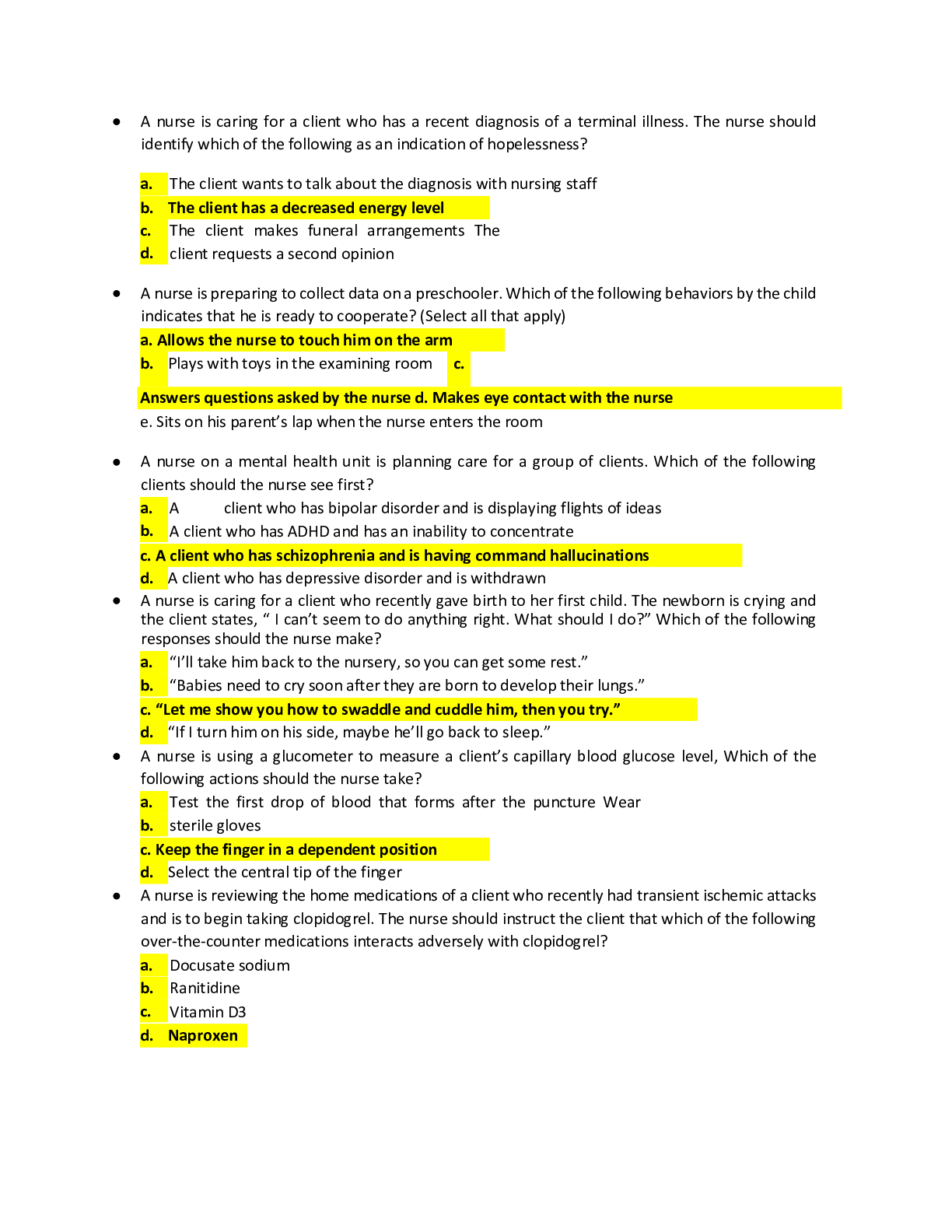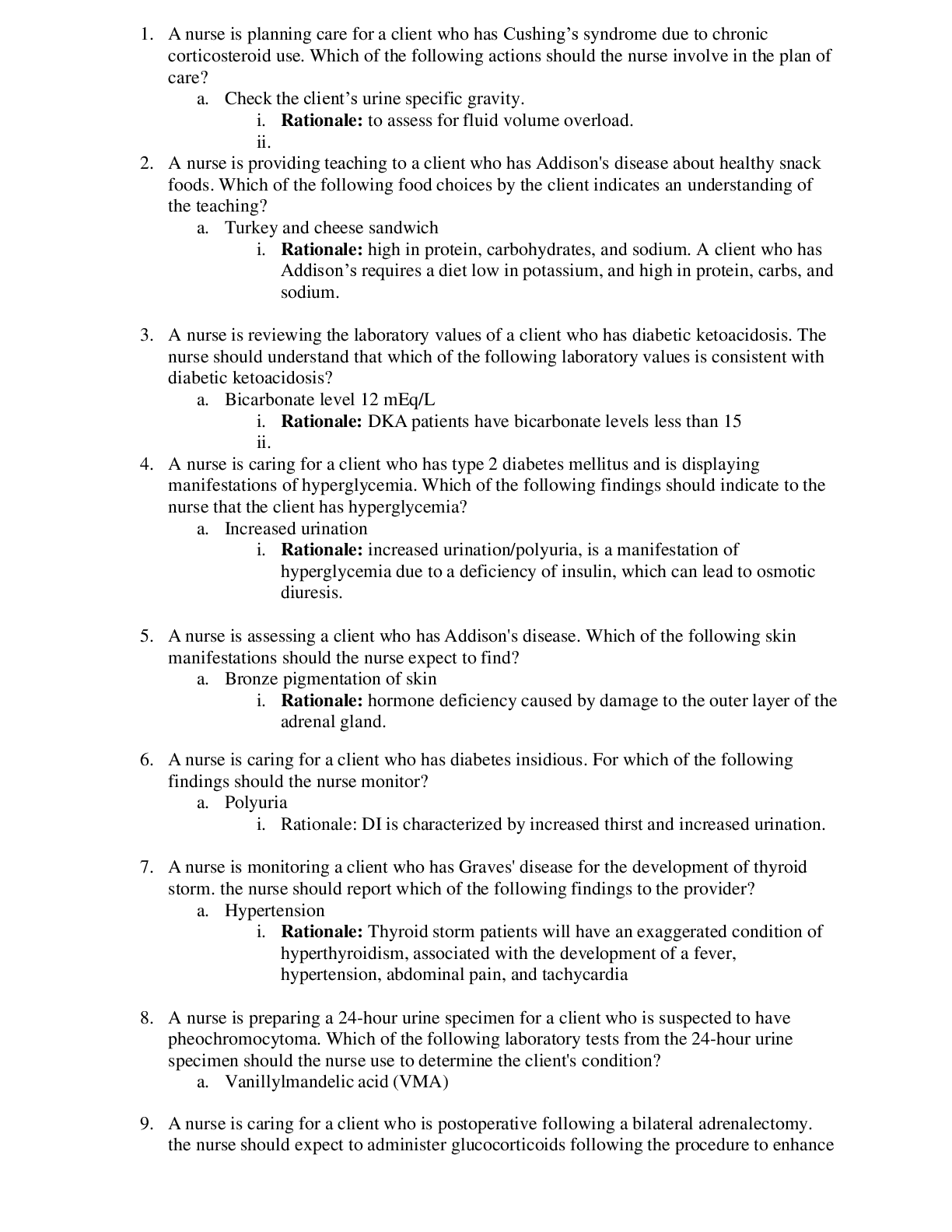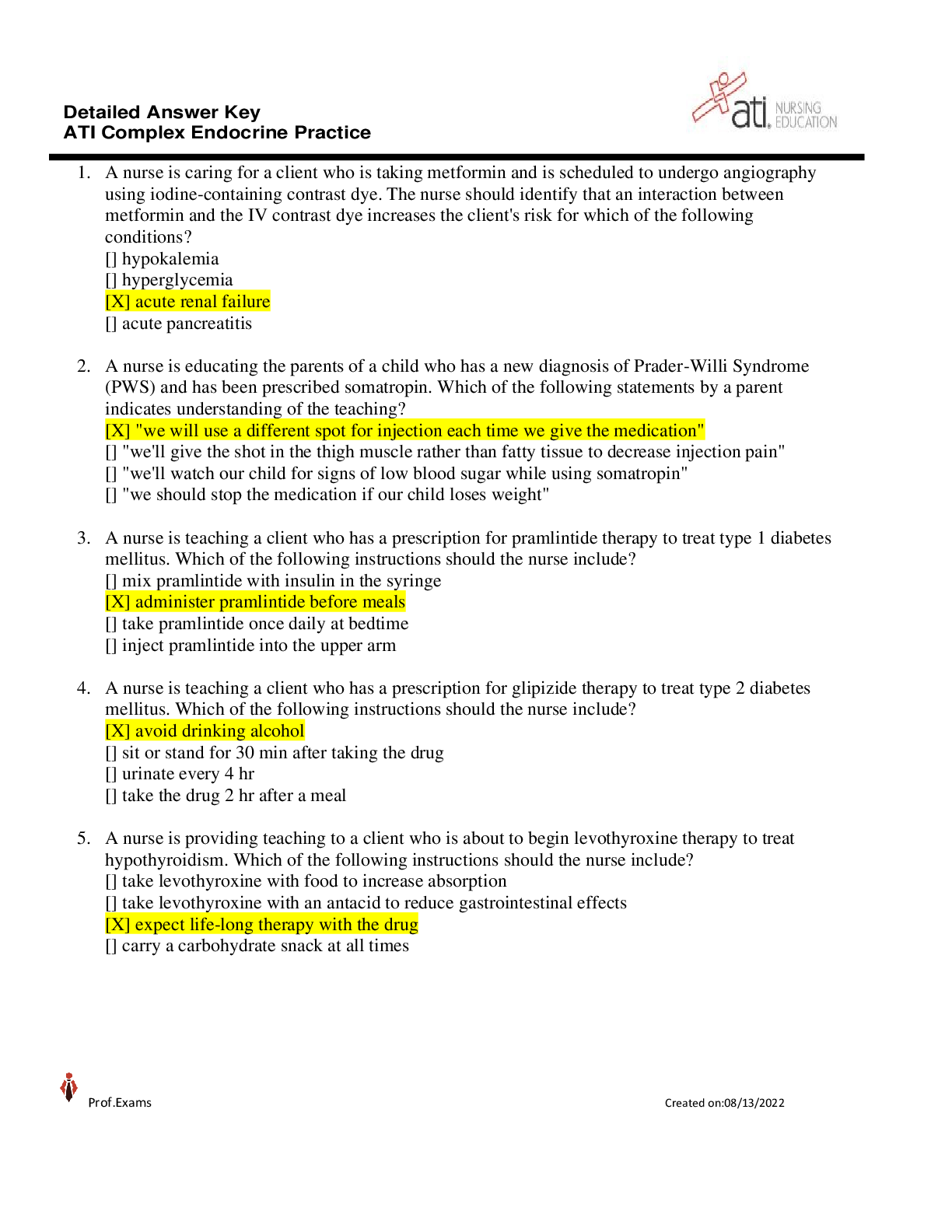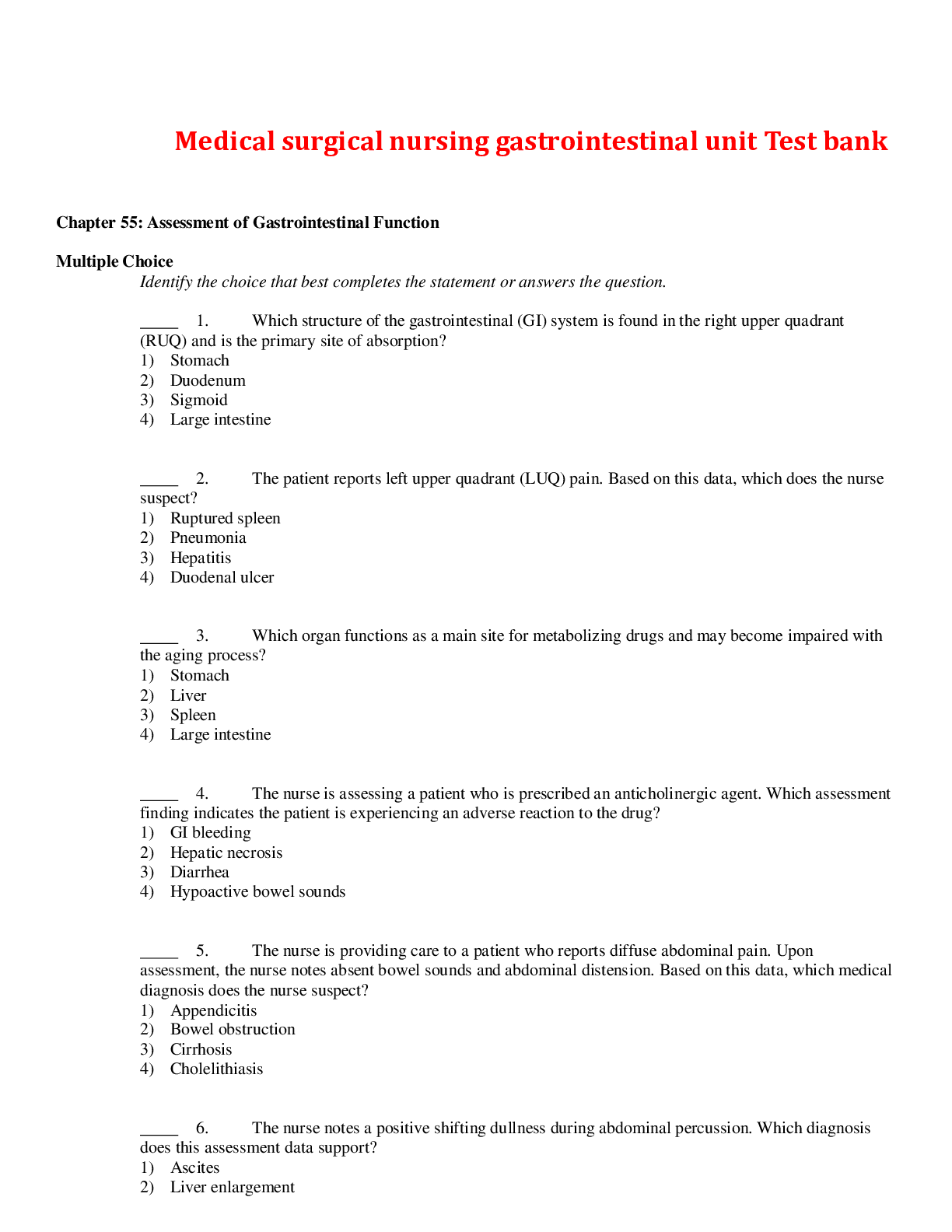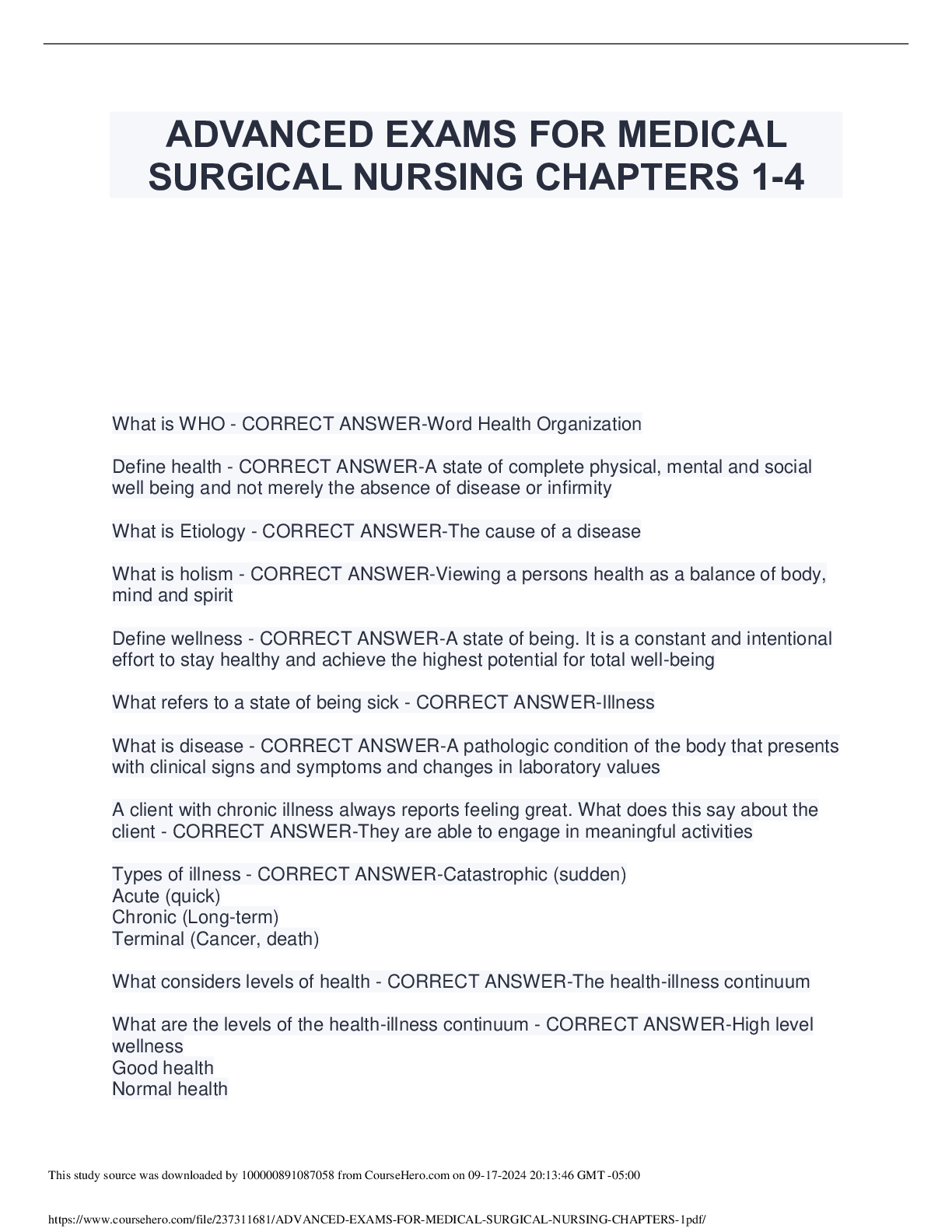100 Item MEDICAL SURGICAL Nursing Examination Correct answers and rationales
Document Content and Description Below
Question Pool MEDICAL SURGICAL NURSING DISCLAIMER: Care has been taken to verify that all answers and rationale below are accurate. Please comment up if you noticed any errors or contradictions to m... aintain accuracy and precision of the answers as not to mislead the readers. SITUATION: Dervid, A registered nurse, witnessed an old woman hit by a motorcycle while crossing a train railway. The old woman fell at the railway. Dervid Rushed at the scene. 1. As a registered nurse, Dervid knew that the first thing that he will do at the scene is [3] A. Stay with the person, Encourage her to remain still and Immobilize the leg while While waiting for the ambulance. B. Leave the person for a few moments to call for help. C. Reduce the fracture manually. D. Move the person to a safer place. * The old woman is in the middle of a train railway. It is very unsafe to immobilize here legs and remain still at the middle of a railway considering that a train might come anytime while waiting for an ambulance. Safety is the utmost importance at this point. If letter D is not among the choices and the situation is a little less dangerous, the answer will be A. Remember that in all cases of emergencies, removing the victim from the scene to a much safer place is a priority. 2. Dervid suspects a hip fracture when he noticed that the old woman’s leg is [4] A. Lengthened, Abducted and Internally Rotated. B. Shortened, Abducted and Externally Rotated. C. Shortened, Adducted and Internally Rotated. D. Shortened, Adducted and Externally Rotated. * SADDER should be your keyword. A hip fracture will produce a SHORTENED, ADDUCTED AND EXTERNALLY ROTATED extremity. Treatment will evolve in casting the leg and putting it in an EXTENSION, NEUTRALLY POSITIONED and SLIGHT INTERNAL ROTATION. In Hip prosthesis, The nurse should maintain the client’s leg in FLEXION, EXTERNAL ROTATION and ABDUCTION to prevent the dislocation of the prosthesis from the acetabulum. Take note of the difference because I mistakenly answered the LATTER in casting a hip fracture thinking that it is similar to a the leg positioning in hip dislocation. Just imagine a patient with a cast that has his leg in ABDUCTION, EXTERNAL ROTATION AND FLEXION. It will cause flexion contractures. 3. The old woman complains of pain. John noticed that the knee is reddened, warm to touch and swollen. John interprets that this signs and symptoms are likely related to [2] A. Infection C. Thrombophlebitis B. Inflammation D. Degenerative disease 4. The old woman told John that she has osteoporosis; Dervid knew that all of the following factors would contribute to osteoporosis except [4] A. Hypothyroidism B. End stage renal disease C. Cushing’s Disease D. Taking Furosemide and Phenytoin. * After a trauma, Inflammation will start almost instantly. Infection occurs 24-48 hours after bone fracture and not immediately. Thrombophlebitis occurs within 4 to 7 days of hospitalization after prolonged immobilization. There is no evidence that the client has a degenerative disease and degenerative diseases will manifest in variety of ways and not after a trauma. * B,C,D all contributes to bone deminiralization except HYPOTHYROIDISM. Hyperthyroidism will contribute to bone deminiralization as well as Hyperparathyroidism due to the increase in PTH, It will cause the movement of calcium from the bone to the blood causing HYPERCALCEMIA. ESRD will cause increase in PHOPHSATE due to its poor excretion. The amount of phosphate is inversely proportional to the amount of calcium. Cushing disease promotes bone demineralization as well as medications like diuretics and anti convulsants. 5. Martha, The old woman was now Immobilized and brought to the emergency room. The X-ray shows a fractured femur and pelvis. The ER Nurse would carefully monitor Martha for which of the following sign and symptoms? [3] A. Tachycardia and Hypotension B. Fever and Bradycardia C. Bradycardia and Hypertension D. Fever and Hypertension . SITUATION: Mr. D. Rojas, An obese 35 year old MS Professor of OLFU Lagro is admitted due to pain in his weight bearing joint. The diagnosis was Osteoarthritis. * hemorrhage results in severing of the vascular supply of the bone of the femur and the pelvis due to the fracture leading to bleeding causing the s/s of tachycardia and hypotension 6. As a nurse, you instructed Mr. Rojas how to use a cane. Mr. Rojas has a weakness on his right leg due to self immobilization and guarding. You plan to teach Mr. Rojas to hold the cane [4] A. On his left hand, because his right side is weak. B. On his left hand, because of reciprocal motion. C. On his right hand, to support the right leg. D. On his right hand, because only his right leg is weak. * Reciprocal motion is a very important aspect of rehabilitation. Mr. Rojas has a weakness on his right leg. If a human moves his right leg, the left arm will accompany the movement of the right leg. That is what you call RECIPROCAL MOTION which is innate, natural and required to maintain balance. Mr. Rojas has weakness in his RIGHT LEG. If we put the cane on his right arm, The client will then be left UNSUPPORTED when he use his stronger leg [LEFT LEG] and stand with his weaker leg [RIGHT LEG] due to the fact that the opposite arm must accompany the movement of the opposite leg [RIGHT ARM]. In a more easier term, Always put the cane on the opposite of the weaker side. A is not correct because the client is NOT hemiplegic and will never be correct to reason out why the cane must always be at the opposite of the weaker side, it will always be due to reciprocal motion. 7. You also told Mr. Rojas to hold the cane [4] A. 1 Inches in front of the foot. B. 3 Inches at the lateral side of the foot. c. 6 Inches at the lateral side of the foot. D. 12 Inches at the lateral side of the foot. 8. Mr. Rojas was discharged and 6 months later, he came back to the emergency room of the hospital because he suffered a mild stroke. The right side of the brain was affected. At the rehabilitative phase of your nursing care, you observe Mr. Rojas use a cane and you intervene if you see him [4] A. Moves the cane when the right leg is moved. B. Leans on the cane when the right leg swings through. C. keeps the cane 6 Inches out to the side of the right foot. D. Holds the cane on the right side. * Remove option A, the client will kick off the cane if it was in the front of the foot. Remove option D because that is too far and will cause the cane to poorly support the client because the side, not the tip, is touching the ground. At 3 inches, imagine how short it is and will cause a very poor supporting base. The correct answer is anywhere from 6 to 10 inches for both crutches and cane. * If the right side of the brain is affected, weakness will always be CONTRALATERAL and therefore, Mr. Rojas will have weakness on his left side. Earlier I told you that cane is held on the opposite side of the weaker side, which in this situation, will be on the RIGHT. Imagine if the client moves his RIGHT LEG together witht the RIGHT CANE, it already violated the LAW OF RECIPROCAL MOTION. Moving the right leg will require Mr. Rojas to move his left arm and not the cane, which is on his right. SITUATION: Alfred, a 40 year old construction worker developed cough, night sweats and fever. He was brought to the nursing unit for diagnostic studies. He told the nurse he did not receive a BCG vaccine during childhood 9. The nurse performs a Mantoux Test. The nurse knows that Mantoux Test is also known as [1] A. PPD B. PDP C. PDD D. DPP 10. The nurse would inject the solution in what route? [1] A. IM B. IV C. ID D. SC . 11. The nurse notes that a positive result for Alfred is [2] A. 5 mm wheal B. 5 mm Induration C. 10 mm Wheal D. 10 mm Induration 12. The nurse told Alfred to come back after [2] A. a week B. 48 hours C. 1 day D. 4 days * Clients are asked to comeback within 2 to 3 days for the reading. . * PPD stands for purified protein derivative. It is used to check for TB exposure. All clients who had BCG need not perform this test because they will always be + * A Wheal is created intradermally and then it is marked and timed. reading will be done within 2 to 3 days * 10 mm Induration [ redness ] is considered positive for individuals with competitive immune response. Wheals are not measured, they will not anymore enlarge. A 5 mm induration is considered positive for patients with AIDS or immunocompromised . 13. Mang Alfred returns after the Mantoux Test. The test result read POSITIVE. What should be the nurse’s next action? [3] A. Call the Physician B. Notify the radiology dept. for CXR evaluation C. Isolate the patient D. Order for a sputum exam [Show More]
Last updated: 2 years ago
Preview 1 out of 29 pages

Buy this document to get the full access instantly
Instant Download Access after purchase
Buy NowInstant download
We Accept:

Reviews( 0 )
$10.00
Can't find what you want? Try our AI powered Search
Document information
Connected school, study & course
About the document
Uploaded On
Sep 13, 2021
Number of pages
29
Written in
Additional information
This document has been written for:
Uploaded
Sep 13, 2021
Downloads
0
Views
154




